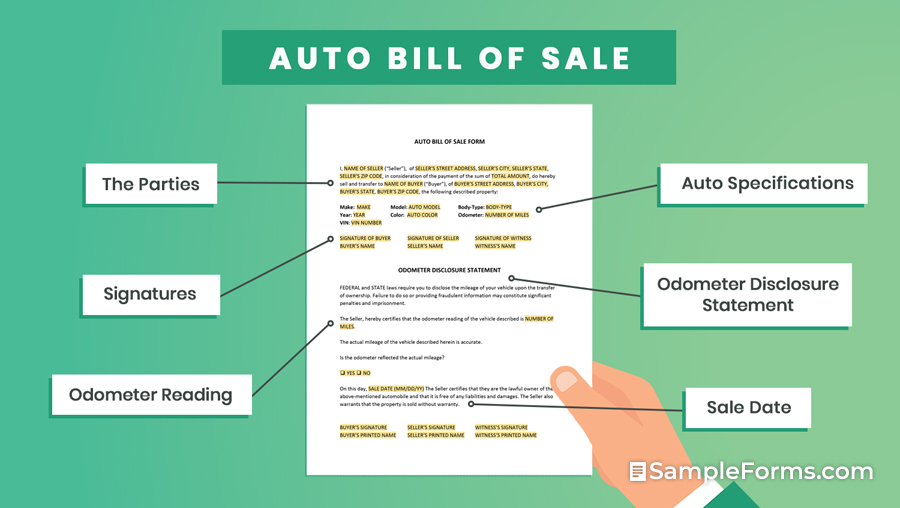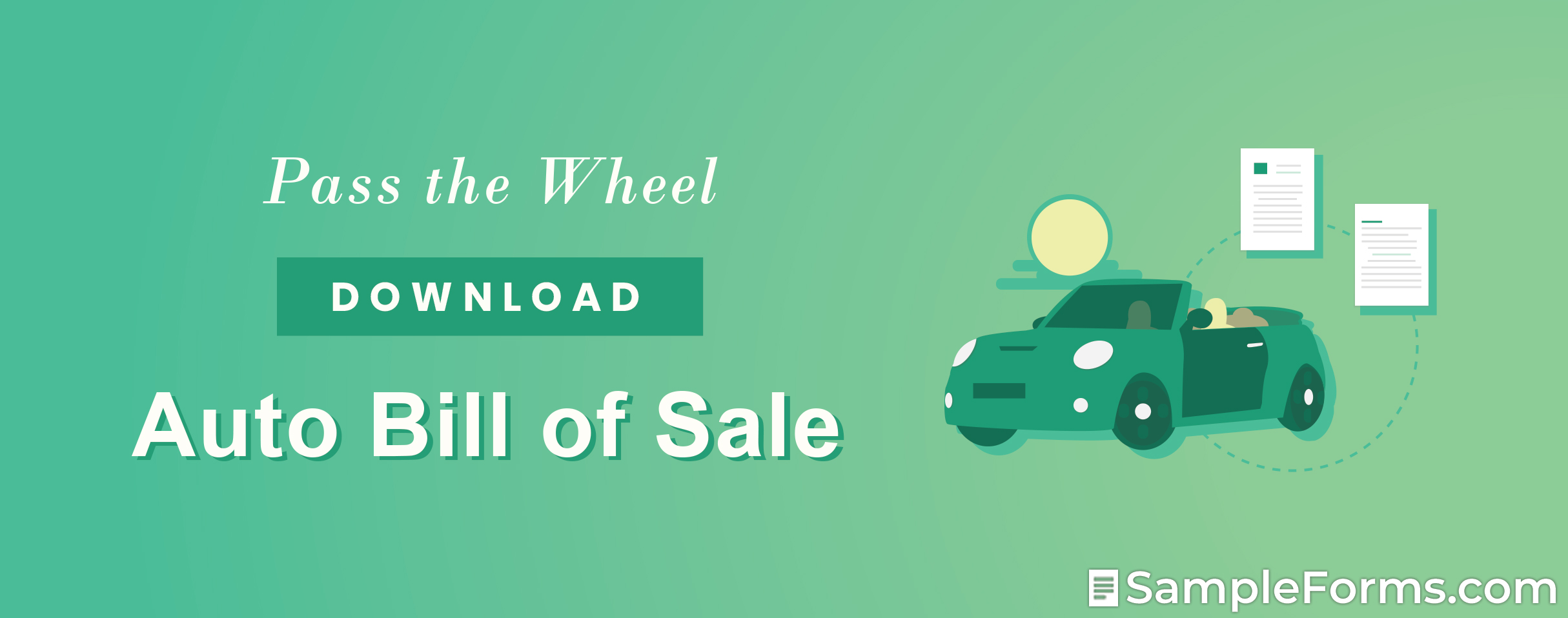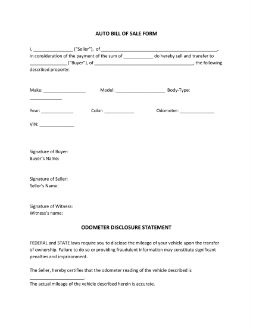- Eviction Notice Forms
- Power of Attorney Forms Forms
- Bill of Sale (Purchase Agreement) Forms
- Lease Agreement Forms
- Rental Application Forms
- Living Will Forms Forms
- Recommendation Letters Forms
- Resignation Letters Forms
- Release of Liability Agreement Forms
- Promissory Note Forms
- LLC Operating Agreement Forms
- Deed of Sale Forms
- Consent Form Forms
- Support Affidavit Forms
- Paternity Affidavit Forms
- Marital Affidavit Forms
- Financial Affidavit Forms
- Residential Affidavit Forms
- Affidavit of Identity Forms
- Affidavit of Title Forms
- Employment Affidavit Forms
- Affidavit of Loss Forms
- Gift Affidavit Forms
- Small Estate Affidavit Forms
- Service Affidavit Forms
- Heirship Affidavit Forms
- Survivorship Affidavit Forms
- Desistance Affidavit Forms
- Discrepancy Affidavit Forms
- Guardianship Affidavit Forms
- Undertaking Affidavit Forms
- General Affidavit Forms
- Affidavit of Death Forms
Auto Bill of Sale
When one decides to sell or transfer an automobile to another, you need a proper legal document to recognize the receiving individual as the official owner of said automobile. In the case of vehicles or automobiles, vehicle bills of sale are made according to the vehicle that’s being sold—in this case, an auto bill of sale is what you need. This type of bill of sale indicates the distinguishing features of the automobile that you are selling. To get a comprehensive and clearer picture of an auto bill of sale, read on below. Read More
What Is an Auto Bill of Sale?

An auto bill of sale is a legal document used to sell and transfer the ownership of an automobile. It consists of the buyer’s and seller’s information, the auto’s detailed description, the payment, and the terms and conditions agreed upon by the buyer and the seller. Each auto bill of sale is catered to fit the Federal and State laws, and in some states, a bill of sale must be notarized.
How to Create a Comprehensive Auto Bill of Sale?
Automobiles are among the most modern and convenient means of transportation. Aside from the protection against noise and air pollution, it offers the driver and its passengers a comfortable ride to their destination. But how safe are automobiles? In a traffic crash, motorcyclists are 28 times more likely to die compared to car passengers. But neither motorcycles nor cars are to blame here—it’s the responsibility of the driver, no matter what they are driving to pay attention to the road, to be sober, and to be physically alert at all times.
You can create your comprehensive auto bill of sale in the comforts of your home. Take a look at our helpful tips below to help you out.
1. Do Your Research
Look for inspiration of what an auto bill of sale looks like. Look for samples or templates to help you get started. Make sure to build your vehicle bill of sale from reliable sources to ensure its credibility and accuracy. For a clear-cut form, downloading the bill of sale templates is highly encouraged. Some websites help you build your bill of sale by answering questions that are appropriate for each state.
2. Supply the Parties’ Information
This section will identify the parties involved in the transaction. This will identify the buyer and the seller. To get their names and addresses right, use a government-issued identification card as your reference.
3. Include the Automobile’s Description
The automobile’s description includes the maker, year, VIN, model, color, body type, and odometer. These are the distinguishing features of the vehicle. Make its title and registration papers as your reference.
4. Establish the Pricing
In order not to arouse suspicion, price your automobile accordingly. The price should be lesser than your original purchase price, depending on the time you have used the vehicle. The price should be backed by receipts and other relevant documents to justify your pricing.
If you are selling the automobile without warranty, indicate that the vehicle is sold in “as is” condition.
5. Sign the Document
Signatures are an indication that both parties have arrived at a mutual decision. Sign the document with the printed names and dates. After signing, you are now ready to transfer the title to its new owner. Both parties should keep copies of the auto bill of sale.
The notarization of the bill of sale depends on the state. If you belong to Louisiana, Maryland, Nebraska, New Hampshire, and West Virginia, then you should have your bill of sale notarized.
FAQs
Do I need a bill of sale when buying or selling a car?
States such as Alabama, Arkansas, Colorado, Connecticut, Hawaii, Idaho, Maine, Nebraska, New York, Ohio, Rhode Island, South Dakota, Vermont, Washington, West Virginia, and Wyoming require a bill of sale when buying or selling a car. The Department of Motor Vehicles (DMV) requires a bill of sale before its registration.
Is there a standard format for a bill of sale?
No. As long as it has the buyer’s and seller’s information, vehicle’s description, terms and conditions, payment details, and in some conditions, an odometer disclosure statement, then you’re good to go.
Is a bill of sale considered legally binding?
Yes, according to Up Counsel, it is an agreement between the buyer and seller and the goods given and received. Certain actions are required and prohibited following the stipulations of the agreement. The bill of sale will be considered a piece of evidence or proof that a sale has been made.
What are some proofs that I sold my car?
According to Finder, a sales tax form, a title certificate bearing the new owner’s name, and a bill of sale is acceptable proofs that you sold your car. If these aren’t enough, you may contact the buyer for additional proofs.
Can I void a bill of sale?
Yes, if the buyer did not provide payment or some security three days after the sale. Another reason to void the bill of sale is if the buyer files for bankruptcy or any other reason that prohibits them from paying.
Buying vehicles from a casual seller can expose you to apparent risks such as fraudulent identification, title jumping, and many more. Seeking legal action will cost you unnecessary expenses and emotional stress—so, why not opt for the right option? This right option is acquiring an auto bill of sale that protects both parties. This bill of sale, among other types, is a legal document that is acceptable in the court of law when settling disputes.

